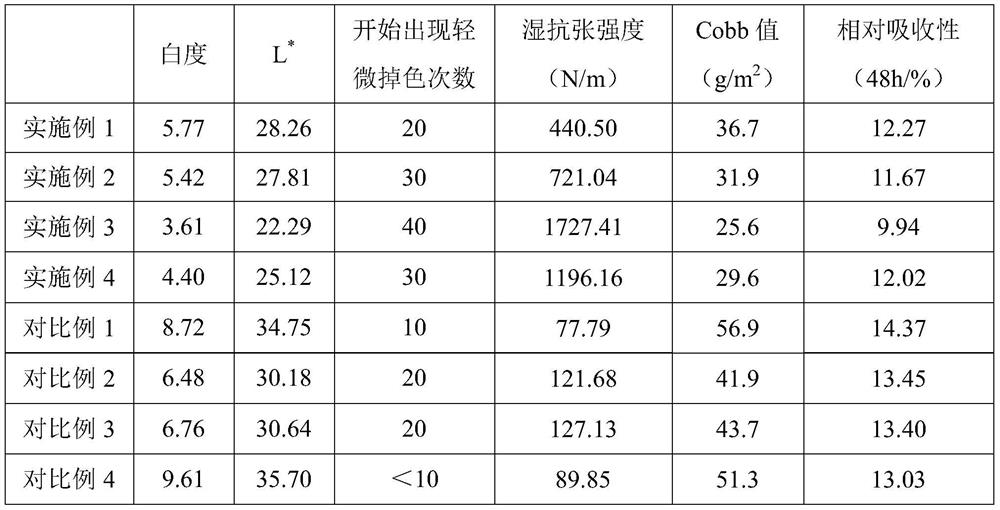Dyed paper as well as preparation method and application thereof
A technology for dyeing paper and dyeing pulp, applied in the field of dyeing, can solve the problems of poor dyeing effect, low mechanical properties, difficulty in dyeing, etc., and achieve the effects of good hygroscopicity, low beating degree, and easy dyeing
- Summary
- Abstract
- Description
- Claims
- Application Information
AI Technical Summary
Problems solved by technology
Method used
Image
Examples
Embodiment 1
[0059] (1) Slurry preparation: tear up an appropriate amount of natural-color bamboo pulp and natural-color bagasse pulp (the absolute dry mass ratio of natural-color bamboo pulp and natural-color bagasse pulp is 6:4), add them into water and fully soak them, and decompose (decompose to pulp The fiber is dispersed, and there is no pulp lump, which can be decomposed by a conventional deflaker), then fished out and squeezed dry to balance the water (balance the water to make the moisture of each part of the decomposed pulp tend to be consistent), to obtain the mixed pulp, and set aside. Get a certain amount of mixed pulp, add viscose fiber that accounts for 2% of the quality of the mixed pulp (i.e. natural color bamboo pulp and natural color bagasse pulp), and then add toner (accounting for 5.8% black toner of the mixed pulp quality, 0.85% blue color powder) powder, 0.3% red toner), add water to a slurry concentration of 10% (mass fraction, the same below), and mix the slurry and...
Embodiment 2
[0062] (1) Slurry preparation: tear up an appropriate amount of natural-color bamboo pulp and natural-color bagasse pulp (the absolute dry mass ratio of natural-color bamboo pulp and natural-color bagasse pulp is 6:4), add them into water and fully soak them, and decompose (decompose to pulp fibers are dispersed, and no pulp clusters appear), then fish out and squeeze dry to balance the water to obtain mixed pulp for later use. Get a certain amount of mixed pulp, add viscose fiber accounting for 3% of the mixed pulp quality, then add toner (accounting for the black toner of 5.8% of the mixed pulp quality, the blue toner of 0.85%, the red toner of 0.3%), Add water to a slurry concentration of 10%, and mix the slurry and dye. Refining in a PFI refiner to obtain a dyed pulp with a beating degree of 30°SR.
[0063] (2) Preparation of dyed paper: take 4.0g (equivalent to 200g / m 2 Quantitatively) ground slurry, stirred at 45°C for 10 minutes, after stirring, added 10% color fixing...
Embodiment 3
[0065] (1) Slurry preparation: tear up an appropriate amount of natural-color bamboo pulp and natural-color bagasse pulp (the absolute dry mass ratio of natural-color bamboo pulp and natural-color bagasse pulp is 6:4), add them into water and fully soak them, and decompose (decompose to pulp fibers are dispersed, and no pulp clusters appear), then fish out and squeeze dry to balance the water to obtain mixed pulp for later use. Get a certain amount of mixed pulp, add viscose fiber accounting for 5% of the mixed pulp quality, then add toner (accounting for the black toner of 5.8% of the mixed pulp quality, the blue toner of 0.85%, the red toner of 0.3%), Add water to a slurry concentration of 10%, and mix the slurry and dye. Refining in a PFI refiner to obtain a beating degree of 25°SR for the dyed pulp.
[0066] (2) Preparation of dyed paper: take 4.0g (equivalent to 200g / m 2 Quantitatively) ground slurry, stirred at 65°C for 20 minutes, after stirring, added 15% color fixin...
PUM
 Login to View More
Login to View More Abstract
Description
Claims
Application Information
 Login to View More
Login to View More - R&D
- Intellectual Property
- Life Sciences
- Materials
- Tech Scout
- Unparalleled Data Quality
- Higher Quality Content
- 60% Fewer Hallucinations
Browse by: Latest US Patents, China's latest patents, Technical Efficacy Thesaurus, Application Domain, Technology Topic, Popular Technical Reports.
© 2025 PatSnap. All rights reserved.Legal|Privacy policy|Modern Slavery Act Transparency Statement|Sitemap|About US| Contact US: help@patsnap.com


